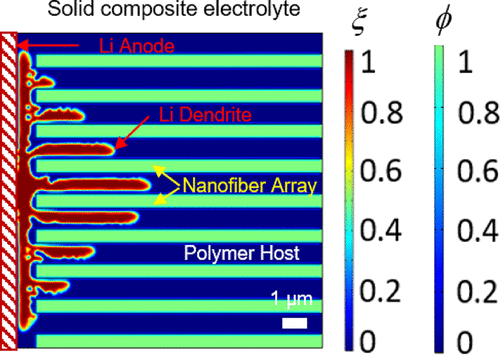当前位置:
X-MOL 学术
›
J. Phys. Chem. C
›
论文详情
Our official English website, www.x-mol.net, welcomes your
feedback! (Note: you will need to create a separate account there.)
Inhibit of Lithium Dendrite Growth in Solid Composite Electrolyte by Phase-Field Modeling
The Journal of Physical Chemistry C ( IF 3.3 ) Pub Date : 2020-05-14 , DOI: 10.1021/acs.jpcc.0c01116 Yao Ren 1 , Yue Zhou 2 , Ye Cao 1
The Journal of Physical Chemistry C ( IF 3.3 ) Pub Date : 2020-05-14 , DOI: 10.1021/acs.jpcc.0c01116 Yao Ren 1 , Yue Zhou 2 , Ye Cao 1
Affiliation

|
Lithium (Li) dendrite growth poses serious challenges for the development of Li metal batteries. Replacing liquid electrolyte with solid composite electrolyte embedded with nanofiller additives can potentially suppress the Li dendrite growth. However, the underlying mechanism is still not fully understood, and most theoretical works focus on pure liquid electrolyte and ignore the mechanical strain effects. Here we developed a phase-field model to simulate the Li dendrite growth by incorporating the microstructure of the solid composite electrolyte and considering the mechanical effects of the electrolyte. Using aluminum oxide nanofiber embedded poly(vinylidene fluoride-co-hexafluoropropylene) (P(VDF-HFP)) as an example, we discovered two key factors, the elastic modulus and the electrolyte nanochannel width that govern the Li dendrite growth. The difference of the Young’s modulus between the Li metal and solid electrolyte acts as the additional mechanical driving force, which partially offsets the electrochemical driving force to either promote or inhibit the dendrite growth. We also discovered that the introduction of the 1D nanofiber arrays could confine the Li ion transport along vertical direction, reduce the concentration gradient across the metal/electrolyte interface, and inhibit the Li dendrite growth. Finally, the dependence of overall Li ion conductivity on the nanofiller is discussed. Our work provides deep understanding and designing strategy for the solid composite electrolyte for improved Li anode stability and Li ion conductivity.
中文翻译:

相场模拟抑制固体复合电解质中锂枝晶的生长
锂(Li)枝晶的生长对锂金属电池的发展提出了严峻的挑战。用嵌入纳米填料添加剂的固体复合电解质代替液体电解质可以潜在地抑制Li树枝状晶体的生长。然而,其根本机理仍未完全理解,并且大多数理论工作集中在纯液体电解质上,而忽略了机械应变效应。在这里,我们建立了一个相场模型,通过结合固体复合电解质的微观结构并考虑电解质的机械作用来模拟Li枝晶的生长。以氧化铝纳米纤维嵌入的聚偏二氟乙烯-共-六氟丙烯(P(VDF-HFP))为例,我们发现了两个关键因素,即弹性模量和控制锂枝晶生长的电解质纳米通道宽度。Li金属和固体电解质之间的杨氏模量之差用作附加的机械驱动力,其部分抵消了电化学驱动力以促进或抑制枝晶生长。我们还发现,引入一维纳米纤维阵列可以限制Li离子在垂直方向上的传输,减少整个金属/电解质界面的浓度梯度,并抑制Li树枝状晶体的生长。最后,讨论了整体锂离子电导率对纳米填料的依赖性。我们的工作为固体复合电解质提供了深刻的理解和设计策略,以提高锂阳极稳定性和锂离子电导率。这部分抵消了电化学驱动力,从而促进或抑制了树枝状晶体的生长。我们还发现,引入一维纳米纤维阵列可以限制Li离子在垂直方向上的传输,降低整个金属/电解质界面的浓度梯度,并抑制Li树枝状晶体的生长。最后,讨论了整体锂离子电导率对纳米填料的依赖性。我们的工作为固体复合电解质提供了深刻的理解和设计策略,以提高锂阳极稳定性和锂离子电导率。这部分抵消了电化学驱动力,从而促进或抑制了树枝状晶体的生长。我们还发现,引入一维纳米纤维阵列可以限制Li离子在垂直方向上的传输,降低整个金属/电解质界面的浓度梯度,并抑制Li树枝状晶体的生长。最后,讨论了整体锂离子电导率对纳米填料的依赖性。我们的工作为固体复合电解质提供了深刻的理解和设计策略,以提高锂阳极稳定性和锂离子电导率。降低金属/电解质界面上的浓度梯度,并抑制锂枝晶的生长。最后,讨论了整体锂离子电导率对纳米填料的依赖性。我们的工作为固体复合电解质提供了深刻的理解和设计策略,以提高锂阳极稳定性和锂离子电导率。降低金属/电解质界面上的浓度梯度,并抑制锂枝晶的生长。最后,讨论了整体锂离子电导率对纳米填料的依赖性。我们的工作为固体复合电解质提供了深刻的理解和设计策略,以提高锂阳极稳定性和锂离子电导率。
更新日期:2020-05-14
中文翻译:

相场模拟抑制固体复合电解质中锂枝晶的生长
锂(Li)枝晶的生长对锂金属电池的发展提出了严峻的挑战。用嵌入纳米填料添加剂的固体复合电解质代替液体电解质可以潜在地抑制Li树枝状晶体的生长。然而,其根本机理仍未完全理解,并且大多数理论工作集中在纯液体电解质上,而忽略了机械应变效应。在这里,我们建立了一个相场模型,通过结合固体复合电解质的微观结构并考虑电解质的机械作用来模拟Li枝晶的生长。以氧化铝纳米纤维嵌入的聚偏二氟乙烯-共-六氟丙烯(P(VDF-HFP))为例,我们发现了两个关键因素,即弹性模量和控制锂枝晶生长的电解质纳米通道宽度。Li金属和固体电解质之间的杨氏模量之差用作附加的机械驱动力,其部分抵消了电化学驱动力以促进或抑制枝晶生长。我们还发现,引入一维纳米纤维阵列可以限制Li离子在垂直方向上的传输,减少整个金属/电解质界面的浓度梯度,并抑制Li树枝状晶体的生长。最后,讨论了整体锂离子电导率对纳米填料的依赖性。我们的工作为固体复合电解质提供了深刻的理解和设计策略,以提高锂阳极稳定性和锂离子电导率。这部分抵消了电化学驱动力,从而促进或抑制了树枝状晶体的生长。我们还发现,引入一维纳米纤维阵列可以限制Li离子在垂直方向上的传输,降低整个金属/电解质界面的浓度梯度,并抑制Li树枝状晶体的生长。最后,讨论了整体锂离子电导率对纳米填料的依赖性。我们的工作为固体复合电解质提供了深刻的理解和设计策略,以提高锂阳极稳定性和锂离子电导率。这部分抵消了电化学驱动力,从而促进或抑制了树枝状晶体的生长。我们还发现,引入一维纳米纤维阵列可以限制Li离子在垂直方向上的传输,降低整个金属/电解质界面的浓度梯度,并抑制Li树枝状晶体的生长。最后,讨论了整体锂离子电导率对纳米填料的依赖性。我们的工作为固体复合电解质提供了深刻的理解和设计策略,以提高锂阳极稳定性和锂离子电导率。降低金属/电解质界面上的浓度梯度,并抑制锂枝晶的生长。最后,讨论了整体锂离子电导率对纳米填料的依赖性。我们的工作为固体复合电解质提供了深刻的理解和设计策略,以提高锂阳极稳定性和锂离子电导率。降低金属/电解质界面上的浓度梯度,并抑制锂枝晶的生长。最后,讨论了整体锂离子电导率对纳米填料的依赖性。我们的工作为固体复合电解质提供了深刻的理解和设计策略,以提高锂阳极稳定性和锂离子电导率。


















































 京公网安备 11010802027423号
京公网安备 11010802027423号